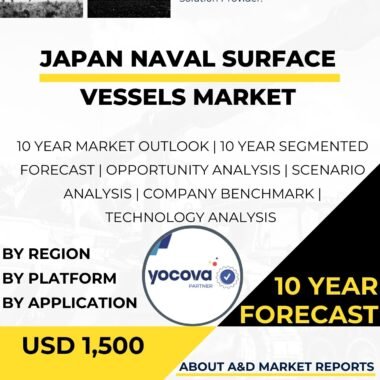Description
The China naval surface vessels market has witnessed significant growth and development in recent years. With China’s focus on modernizing its naval capabilities and expanding its maritime presence, there has been a substantial demand for advanced naval surface vessels. This market analysis provides an overview of the China naval surface vessels market, including key players, market drivers, challenges, and future prospects.
The China naval surface vessels market is characterized by the presence of both domestic and international players. Domestic shipbuilding companies, such as China State Shipbuilding Corporation (CSSC), China Shipbuilding Industry Corporation (CSIC), and China Merchants Group, have made significant contributions to the development, construction, and supply of naval surface vessels. These companies have invested in research and development to enhance the capabilities of their vessels and meet the specific requirements of the Chinese Navy.
International players, including renowned shipbuilders such as Huntington Ingalls Industries, BAE Systems, and Damen Shipyards, have also established collaborations and joint ventures in China, leveraging their expertise and technologies in shipbuilding. These partnerships have contributed to the development and construction of advanced naval surface vessels in China.
The market is driven by several factors. One of the primary drivers is China’s need to enhance its maritime presence and protect its maritime interests. As China seeks to expand its naval capabilities and assert its sovereignty in contested maritime regions, the demand for advanced naval surface vessels has grown. These vessels play a crucial role in various naval operations, including maritime security, anti-submarine warfare, anti-aircraft defense, and power projection.
Technological advancements have played a crucial role in the growth of the China naval surface vessels market. Domestic shipbuilding companies have focused on developing indigenous surface vessels with improved capabilities, including advanced sensors, weapons systems, and propulsion technologies. China has made significant progress in the development of various surface vessels, including destroyers, frigates, corvettes, and amphibious assault ships.
China has successfully developed and deployed advanced surface vessels, such as the Type 055 destroyer, which boasts advanced sensors, long-range strike capabilities, and sophisticated air defense systems. The development of the Type 052D destroyer and the Type 054A frigate has also strengthened China’s naval capabilities in terms of anti-aircraft defense, anti-submarine warfare, and surface warfare.
Furthermore, China has made notable advancements in the construction of corvettes, such as the Type 056, which is a multi-purpose vessel with capabilities for anti-submarine warfare, anti-surface warfare, and coastal defense. Amphibious assault ships, such as the Type 071, provide China with enhanced capabilities for power projection, amphibious operations, and humanitarian assistance and disaster relief (HADR) missions.
Another driver of the China naval surface vessels market is the export market. China has emerged as a major exporter of naval vessels, offering cost-effective solutions to countries seeking to enhance their naval capabilities. The Belt and Road Initiative (BRI) has provided opportunities for China to export its naval surface vessels to partner countries, expanding its market presence globally.
However, the China naval surface vessels market also faces certain challenges. One of the primary challenges is the need for continuous research and development to keep pace with evolving naval warfare requirements and emerging technologies. As adversaries develop more advanced naval technologies and seek to neutralize naval vessels, China must invest in innovation and advanced shipbuilding techniques to maintain its technological edge.
Additionally, the market faces challenges related to international export restrictions and intellectual property rights. The development and export of naval surface vessels are subject to strict regulations due to security concerns. This can limit market opportunities and hinder collaboration with international partners.
Looking ahead, the future prospects for the China naval surface vessels market are promising. China’s commitment to military modernization and indigenous defense capabilities will continue to drive investments in naval surface vessels. Ongoing research and development efforts, collaborations between domestic shipbuilders and international partners, and the integration of emerging technologies are expected to result in the introduction of more advanced and capable naval surface vessels.
The integration of emerging technologies, such as artificial intelligence (AI), unmanned systems, and advanced materials, may shape the future of the market. AI-powered systems can enhance vessel autonomy, decision-making, and operational efficiency. The use of unmanned systems, including unmanned surface vessels (USVs) and unmanned aerial vehicles (UAVs), can enhance surveillance, reconnaissance, and maritime security capabilities. The use of advanced materials, such as lightweight composites and stealth technologies, can improve vessel performance, reduce fuel consumption, and enhance stealth capabilities.
In conclusion, the China naval surface vessels market has witnessed significant growth driven by the country’s focus on military modernization and expanding its maritime presence. Technological advancements, collaborations between domestic shipbuilders and international players, and the government’s commitment to indigenous defense capabilities have contributed to the development and construction of advanced naval surface vessels. Challenges related to evolving naval warfare requirements and export restrictions need to be addressed. With ongoing research and development, collaborations, and the integration of emerging technologies, the future of the China naval surface vessels market looks promising, with opportunities for further growth, innovation, and advancements in naval surface vessels.




